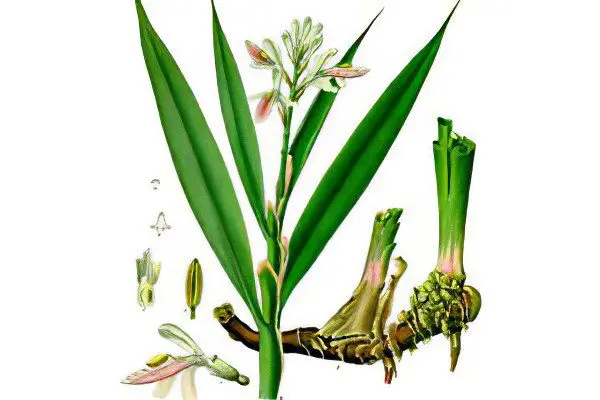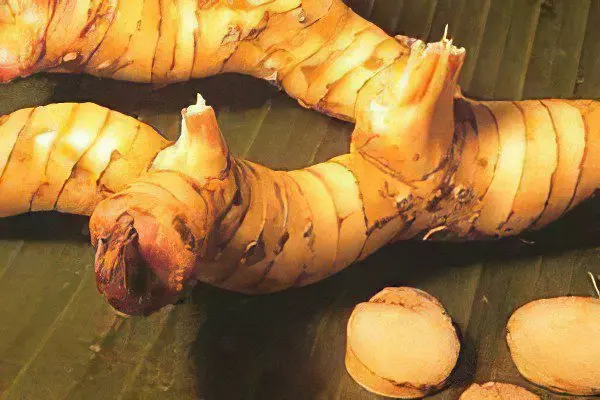Contents
Useful properties and application of alpinia officinalis
Description of alpinia

Alpinia officinalis – This is a delightful tropical plant with a thick red-brown rhizome, which extends horizontally underground and branches very profusely. This large perennial on the roots has ringed leaf scars of a light shade. The height of the stem can reach one and a half meters. As a rule, individual stems emerge from all branches of the rhizome. A well-developed specimen can have up to 40 stems, while only a few will have inflorescences.
Sessile alternate leaves are linear. Their length is about 25 cm. Amazing white flowers are collected in the apical short spike in the form of clusters. The tubular cup is complemented by a short-tubular three-lobed corolla. The white petal lip has red stripes. The fruit of alpinia is represented by a small box. Externally, the plant slightly resembles ginger.
As a rule, to obtain a unique pharmaceutical raw material, it is grown in China on the island of Hainan and on the Leizhou Bandao Peninsula. This grass with two-row lanceolate leaves has more than 200 species, which are widespread in the subtropical regions of Asia. Alpinia can be easily bred at home. It only needs a sufficient amount of light and a temperature of at least 20 ° C heat.
Spraying and watering regularly, and feeding every two weeks during active growth, you can grow a luxurious plant. Faded shoots should be cut off immediately after flowering, leaving the rest to continue growth. During the cold season in winter, alpinia must be kept in the temperature range from 12 to 14 ° C of heat, watering moderately so that the soil is slightly dry.
Reproduction is carried out by dividing the rhizomes, as well as by seeds. You can divide the rhizomes in the spring during the transplant process. Small segments are planted in wide pots or flat low containers. Do not forget about regular uniform watering of planted plants. Fresh seeds are recommended to be sown in boxes and bowls. They will germinate only at temperatures above 22 ° C. A special potting mix that combines equal parts soddy soil, sand and humus will achieve good growth.
Useful properties of alpinia
This plant has unique beneficial properties. It contains special substances with a sharp taste, an essential oil, as well as bitter flavones derivatives and essential eugenol. Sesquiterpenoid alcohols, cineole, galangin, kaempferol and eugenol were found in the rhizomes. The presence of resins and essential oils causes a burning taste. In addition, alpinia contains various flavonoids and tannins. For medicinal purposes, as a rule, aromatic rhizome and seeds are used.
The use of alpinia

Since ancient times, in traditional oriental medicine, small alpinia seeds have been used for cholera, malaria, heartburn, indigestion and severe toothache. Healing rhizomes are indicated for chronic enteritis and other stomach problems and various painful conditions. They are also indispensable for dangerous inflammation of the small intestine. Often this plant is prescribed for indigestion. Along with this, it prevents all kinds of relapses in complex chronic diseases of all internal organs, promotes excellent gas separation, promotes salivation.
It should also be noted that delicious alpinia is indicated to increase the functional activity of the stomach, with exhaustion and lack of appetite. For women, the exceptional properties of the plant are of no small importance, which help to cope with any menstrual disorders, fainting and headaches. Mention may also be made of the curative effects of an enlarged liver, motion sickness, and hypochondria.
With insufficient formation of the necessary enzymes, alpinia is indispensable. Often it is included in the composition of various stomach teas, the healing effect of other herbs. Peerless tinctures are prescribed for various gastrointestinal diseases. In addition to medicinal purposes, in many world cuisines alpinia is also used as an exquisite spice to improve appetite. The spicy aromatic taste and insanely pleasant smell make alpinia seasoning wonderful. This seasoning will make any meat dish incredibly tasty.
To make tea from alpinia, you need 2 tsp. chopped rhizomes and 50 grams of boiling water. Pour the mixture with water and set aside for 5-10 minutes to infuse. Then you should strain. It is necessary to consume 3 times a day, one cup of warm tea before meals. Tea is not recommended to be sweetened.
Alpinia contraindications
Side effects with the use of alpinia have not been identified. With prolonged use as a healing medicine, do not exceed the indicated dosages, and the seasoning should be consumed in large quantities.









